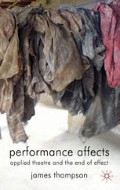Abstract
Part II has attempted to offer both broad and specific approaches to applied theatre that emerge in response to the different ends of effect proposed in Part I. A particular priority for the argument has been to explore the potential political grounds for a community-based and participatory performance practice that, while working often in small, private settings, understands and connects with wider public actions. The intimacy of that hidden moment, however, was not to be forfeited in favour of a stronger avowal of more visible practice, but rather the care exhibited in those settings becomes linked to a particular ethics, and in turn politics, of applied theatre. A politics that, I believe, is in danger of being lost in the eagerness to apply performance at the service of the various institutional, social and discursive regimes that surround and contain the communities in which the practice takes place. The notions of affect and beauty, outlined in the previous two chapters, started to suggest a sensate and aesthetic focus that, I argued, can be linked to notions of social justice. The discussion here will open with an account of ethics that in turn will be connected both to this concern with affect and subsequently to a particular political aspiration for applied theatre. The debate will draw at first on Levinas’s notion of the face, borrowing from discussions of the term in Butler and Critchley, and subsequently suggest how an account of the face-to-face encounter within performance can draw from these arguments.
The dream of a suitable political work of art is in fact the dream of disrupting the relationship between the visible, the sayable, and the thinkable without having to use the terms of a message as a vehicle.
(Ranciè re, 2004, p. 63)
By the time of the landing in France — June 6, 1944 — photographs of anonymous American casualties had appeared in a number of newsmagazines, always prone or shrouded or with their faces turned away.
(Sontag, 2003, p. 63)
Right or wrong, reading the face was here to stay as a type of irreducible folk wisdom of popular culture.
(Taussig, 1999, p. 230)
Access this chapter
Tax calculation will be finalised at checkout
Purchases are for personal use only
Preview
Unable to display preview. Download preview PDF.
Copyright information
© 2009 James Thompson
About this chapter
Cite this chapter
Thompson, J. (2009). About Face: Disturbing the Fabric of the Sensible. In: Performance Affects. Palgrave Macmillan, London. https://doi.org/10.1057/9780230242425_7
Download citation
DOI: https://doi.org/10.1057/9780230242425_7
Publisher Name: Palgrave Macmillan, London
Print ISBN: 978-1-349-30713-5
Online ISBN: 978-0-230-24242-5
eBook Packages: Palgrave Literature & Performing Arts CollectionLiterature, Cultural and Media Studies (R0)

